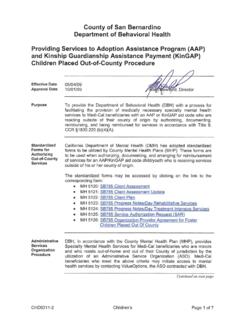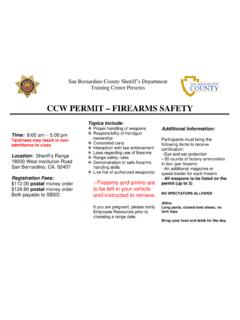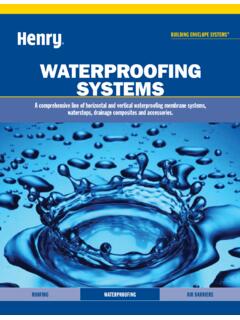Transcription of Percolation Testing and Reporting Standards
1 Percolation Testing and Reporting Standards for Onsite Wastewater Treatment Systems Percolation Test Standards and Report Guide 2 Foreword A soil Percolation report uses water absorption rates for specific parcels of land to determine the appropriate onsite wastewater treatment systems (OWTS) that can be used for proposed development. The soil s Percolation condition at a specific parcel of land is determined by Testing at the site. This information along with topographical, geologic, and hydrologic conditions are determined and described in the report. The OWTS is then designed in accordance with the report and San Bernardino County Standards . A properly installed, operated and maintained OWTS is essential to prevent public health nuisances including odors, groundwater or surface water contamination, and safety hazards associated with premature system failure.
2 Completed soil Percolation reports and required fees must be submitted to Environmental Health Services (EHS) prior to the approval of the use of any OWTS and the application of the design rate. Note: This document was previously titled Onsite Wastewater Disposal System Soil Percolation (PERC) Test Report Standards : Suitability of Lots and Soils for Use of Leach lines or seepage Pits . The title has been updated to reflect the primary purpose of the information presented. Revised September 2019 Percolation Test Standards and Report Guide 3 Table of Contents Definitions_____ 5 Chapter One: PERC Submission Criteria and Requirements _____ 9 Circumstances Requiring Submission of a PERC report _____ 9 Preparer Requirements _____ 9 Chapter Two: Required PERC Format and Content _____ 10 Description of Site and Proposal _____ 10 Proposed Development/Project/Land Use _____ 10 Description of Site and Surroundings _____ 10 Equipment _____ 11 Chapter Three: Methodology and Procedures _____ 12 Location of Borings and Trenchings _____ 12 Minimum Number of Exploratory Borings _____ 13 Chapter Four.
3 Leach Lines Guidance _____ 14 Minimum Number of Tests for Leach lines _____ 14 Standard Percolation Test Procedure for Leach Lines _____ 14 Continuous Pre-Soak Percolation Test Procedure for Leach Lines _____ 15 Results for Leach Lines _____ 17 Figure: Application Rates as Determined from Stabilized Percolation Rate for Leach Lines _____ 18 Discussion of Results _____ 19 design _____ 19 Convert Percolation Times to Leach Lines design Rates _____ 19 Chapter Five: seepage Pits Guidance _____ 20 Minimum Number of Tests for seepage Pit _____ 20 Standard Testing for seepage Pit: Falling Head Percolation Test Procedure _____ 20 Test Results for seepage Pits _____ 22 Discussion of Results _____ 22 design _____ 23 Convert Q to seepage Pit design Rates _____ 23 Chapter Six: Special Criteria _____ 24 Guidelines for Determining the Number of Bedrooms _____ 24 Percolation Test Standards and Report Guide 4 Confluent Systems _____ 24 Credit for Alternating Fields _____ 24 Special Soil Conditions _____ 25 Special Discharge Conditions _____ 25 Alternative Treatment Systems _____ 26 Alternative Sewage Disposal Options_____ 26 Chapter Seven: Plot Plan California Plumbing Code _____ 28 Chapter Eight: General Recommendations _____ 29 APPENDIX _____ 30 Appendix Figure A: Textural Triangle _____ 31 Appendix Figure B: Unified Soil Classification _____ 32 Appendix Figure C: design Soil Application Rates _____ 34 Appendix D: Liquid Waste Disposal Systems _____ 35 Appendix E: Daylight Requirements _____ 38 Appendix F.
4 Special Considerations for Absorption Field Placement in Sloping Ground _____ 38 Appendix G: Gravel Packing Corrections _____ 39 Appendix H: Perennial Streams of San Bernardino County _____ 399 Appendix I: Suggested References _____ 41 Percolation Test Standards and Report Guide 5 Definitions Alternative Onsite Sewage Disposal System Any OWTS that does not meet the criteria of a conventional OWTS, but is allowed under conditions specified by EHS. These include supplemental treatment systems (see separate definition) and alternative dispersal system, such as pressured dose distribution systems. Basin Plan (or Water Quality Control Plan) A plan which identifies surface and ground water bodies within each region s boundaries, and establishes for each, it s respective beneficial uses, and water quality objectives.
5 Basin plans are adopted by the RWQCB and SWRCB, and are approved by the Office of Administrative Law. Bedrock The rock, usually solid, which underlies soil or other unconsolidated, surficial material. Cesspool An excavation in the ground receiving domestic wastewater, designed to retain the organic matter and solids, while allowing the liquids to seep into the soil. Cesspools differ from seepage pits because cesspools do not have a septic tank to pretreat the sewage prior to discharge into the soil. Clay Term used to describe a soil particle, or type of soil texture. As a soil: Particle clay consists of individual rock or mineral particles having diameters of < millimeters (mm). Texture clay is a soil material that is comprised of 40%, or more, clay particles, not more than 45% sand, and not more than 40% silt particles using the United States Department of Agriculture (USDA) soil classification system.
6 Cobbles Rock fragments measuring 76 mm or larger, using the USDA soil classification systems. Dispersal System A type of system for final wastewater treatment and subsurface discharge, which may include a leach field, seepage pit, mound, subsurface drip field, or evapotranspiration and infiltration bed. Domestic Wastewater Wastewater with a measured strength less than high strength wastewater, which is discharged from plumbing fixtures, appliances and other household devices. Effluent Sewage, water, or other liquid (partially or completely treated, or in its natural state), flowing out of a septic tank, aerobic treatment unit, dispersal system, or other OWTS component. Grease Interceptor A passive interceptor with a rate of flow exceeding 50 gallons-per-minute located outside a building, and used for separating and collecting grease from wastewater.
7 Groundwater Water below the land surface that is at, or above, atmospheric pressure. Percolation Test Standards and Report Guide 6 High Strength Wastewater Wastewater, prior to septic tank or other form of OWTS treatment component, having: A 30-day average concentration of Biochemical Oxygen Demand (BOD) greater than 300 milligrams per liter (mg/L), Total Suspended Solids (TSS) greater than 330 mg/L, or A Fats, Oil, and Grease (FOG) concentration greater than 100mg/L. Impaired Water Bodies/303(d) List Surface water bodies, or segments thereof, identified on the Section 303(d) list pursuant to the Federal Clean Water Act, approved by the SWRCB, and United States Environmental Protection Agency (EPA). Local Agency Any subdivision of state government responsible for permitting, installation, and regulation of OWTS within its jurisdictional boundaries; typically a county, city, or special district.
8 Local Agency Management Program (LAMP) A program for the siting, design , operation and maintenance of OWTS, developed by a local agency, and approved by the RWQCB as an alternate method to achieve the same policy purpose as that of OWTS policy. Herein referred to as the Program. Mottling A soil condition that: Results from oxidizing or reducing minerals due to soil moisture changes from saturated to unsaturated over time, Is characterized by spots or blotches of different colors or, shades of color (grays and reds), interspersed within the dominant color as described by the USDA soil classification system, and May indicate historic seasonal high ground water levels. Mound System An above grade dispersal system, having subsurface discharge, used to enhance soil treatment, dispersal, and absorption of effluent discharged from an OWTS treatment unit ( , septic tank).
9 National Sanitation Foundation (NSF) International A not for profit, non-governmental organization which develops health and safety Standards , and performs product certification. Onsite Wastewater Treatment Systems (OWTS) Wastewater treatment systems that use subsurface disposal, including: individual; community collection and disposal; and alternative collection and disposal systems. Note: OWTS do not include graywater systems pursuant to Chapter 15 of the California Plumbing Code. Percolation Test A method of Testing water absorption of the soil by using clean water to determine the dispersal system design . Permit A document issued by a local agency that allows the installation, use, and/or monitoring of an OWTS. Percolation Test Standards and Report Guide 7 Qualified Professional An individual licensed, or certified by a State of California agency, to design OWTS and practice as a professional for other associated reports, as allowed under their license or registration.
10 Qualified Professionals include the following: Registered Civil Engineers Certified Engineering Geologists Registered Environmental Health Specialists (REHSs) Registered Geologists Geotechnical Engineers. Replacement OWTS An OWTS that, after the effective date of this LAMP, has its treatment capacity expanded or its dispersal system replaced or added onto. Regional Water Quality Control Board (RWQCB) Regional Water Board is any of the Regional Water Quality Control Boards designated by California Water Code Section 13200. Any reference to an action of the Regional Water Board in this Policy also refers to an action of its Executive Officer. Depending on the site specific location of the OWTS, Regional Water Board reference in this document may refer to the Colorado River Basin Water Board, the Lahontan Water Board, or the Santa Ana Water Board.











